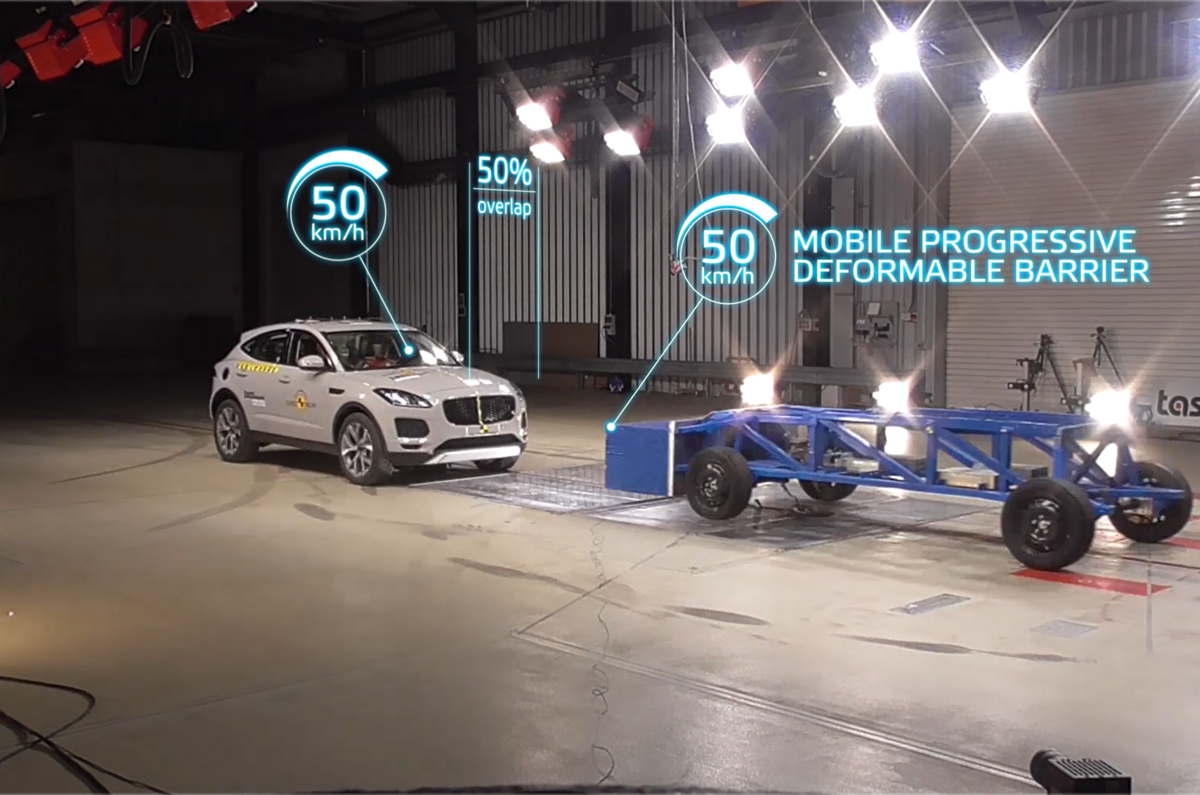Euro NCAP has overhauled its testing regime for 2020, with the introduction of new methods to assess crash safety and active safety technology.
Described as “the biggest change to Euro NCAP’s impact testing protocols in a decade” by Thatcham Research director and Euro NCAP board member Matthew Avery, the new regime will be introduced later this year.
The first key change is the adoption of a new “Mobile-offset Progressive Deformable Barrier”, meaning there are now two moving elements to a head-on collision test. Intrusion to both the vehicle and barrier will be measured. The idea, Avery says, is to “encourage makers of larger vehicles to share some of the burden of the impact with smaller vehicles.
“Historically, SUVs and other big cars have offered very good protection to their occupants. However, the smaller vehicles they sometimes crash into can fare less well. In the new compatibility test, if the larger vehicle is too stiff for an impact scenario, it will be penalised accordingly.”
An advanced new crash test dummy, dubbed THOR, has also been introduced. It is said to more closely represent a human, and Avery describes it as “far more complex and sensitive and can record abdominal injuries”.
Side impact testing will also now take into account the movements of all occupants, not just those closest to the impact, checking airbags installed in centre compartments.
Automatic emergency braking systems will also be further tested with a new 'Turn Across Path’ protocol, aimed at preventing accidents at junctions and crossings. Reverse parking incidents will also be taken into account, while driver monitoring systems will be assessed.
Finally, Euro NCAP will consider post-crash safety, looking at which cars provide accurate information to emergency services in the event that the vehicle needs to be cut open to gain access.
As with previous changes to the testing and marking protocol, Euro NCAP cautions against comparing the newly tested cars with rivals that have undergone the older, theoretically easier tests.
READ MORE:
Euro NCAP on the future of road safety




Join the debate
Add your comment
@takeitslowly
Firstly; when a vehicle undergoes an emissions test, it either passes or fails. Having passed the test, the test which it passed is specifically stated in the specification - Euro5, for example. If the specifications of a vehicle simply stated "yes" for emissions, with this later being revised to "no" when a more stringent standard is introduced, the system becomes of no use to anybody. Why shouldn't crash test results also state the generation of the test the vehicle was subjected to?
Secondly; The larger suv has a higher frontal area, which can impact a cyclist or pedestrian closer to the chest and stomach area, rather than the legs, making it more likely that they may suffer more serious injuries from a slower impact. This has been a safety concern with 4x4 vehicles for decades, beginning with large steel "bullbars" being fitted, and is still an issue regarding their shape in general. There is nothing new being brought up by CWBrown, it has been a problem for decades, your failure to understand or comprehend something doesn't make it a point for ridicule.
Make generations clear
It needs to be clear which generation of testing standards a car is rated by. It isn't currently.
Andy_Cowe wrote:
When a potential buyer is researching their shortlist, the responsibility to also pin down the details of the relevant test, belongs to them. Are you suggesting that the mojority of the car buying public are unable to do basic fact finding, or perhaps you just speak for yourself, in which case, perfectly understandable.
Good old EU moves the goal
Good old EU moves the goal posts to off foot non EU manufacturers like the Chinese who were nearly up to speed on safety and will have to redo design & development. No doubt VAG were incorporating compliance in their designs ages ago.. nod, wink, the draft spec is in the buff envelope on the bench.. shhh!
china lies people die
What? ccp paying you to post pro party line propaganda '50 cent army' member? chinese cars have been corner cutting death traps since the test was introduced in the 90’s.. There is no anti china conspiracy here comrade. I would agree with you on the EU being in bed with ‘certain’ car companies moving goalposts for their own financial gain. One example is the emission standards change which is based off c02 which is BS because it puts lower revving turbo diesel at an unfair advantage. They pump out more poisonous pollutants and particulates than a petrol equivalent engine but pay less road taxes Europe-wide because ved rates are tied to c02 emissions and nothing else. This really harmed non-EU Japanese and US importers where they don’t drink the diesel coolaid in their native countries and had to rush and design derv engines to compete with EU makers putting them at a huge competitive disadvantage.
nimmler wrote:
Well I was partly tongue in cheek, I saw the (Chinese made) MG ZS EV had achieved a 5 star NCAP rating so using some european design input they are getting there as this is an NCAP rating not a manufacturer one. Now they 'know' how to do it other Chinese brands could soon be arriving at bargain prices with 5 stars. Considering the Korean market share now, knees might be trembling on the continent at the prospect of another one taking another chunk.What is the betting certain German brands sail through the new requirements? almost as if they were designed around their cars...hmmm